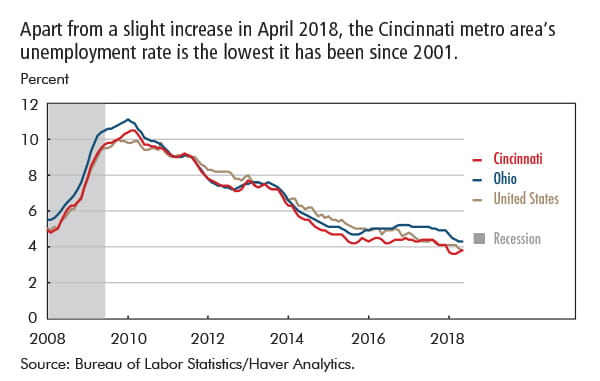Cincinnati economy registers lowest unemployment rates since 2001, according to Cleveland Fed researchers
Positive conditions continue driven by employment gains across multiple industries

The Cincinnati metro area’s unemployment rate increased by 0.1 percentage points in April 2018, but apart from this slight uptick, the region is seeing its lowest unemployment rates in nearly 17 years. Employment in the Cincinnati area grew 1.4 percent in the 12 months leading up to December 2017, compared with 0.8 percent growth across the state of Ohio.
“These data are consistent with anecdotal accounts from firms in the area, which report increasing difficulty finding qualified workers to take available positions,” according to Guhan Venkatu and Mary DeStefano of the Federal Reserve Bank of Cleveland.
Employment growth in the Cincinnati area was led by leisure and hospitality, growing 3.4 percent, and construction, which grew 3.3 percent. Of the eight major employment sectors highlighted in the report, only professional and business services declined in the 12 months leading up to December 2017, falling by 1.2 percent. However, according to Venkatu and DeStefano, this decline deserves special attention. “Because this sector is one of the larger sectors in the Cincinnati metro area in terms of employment and because this sector tends to generate higher wages than other sectors, this is a development worth watching,” they added.
During 2016, per capita GDP growth in the region outpaced both state and national trends. Per capita GDP grew roughly 2.5 percent for the Cincinnati area, in comparison to 0.7 percent for Ohio and 0.8 percent in the US during the same period.
Stepping back to look at longer term trends, Venkatu and DeStefano note that, in the 10-year period from 2006 to 2016, population in the Cincinnati metro area grew almost 5 percent. This can be compared to a near 13 percent increase for Columbus, but a population decrease of 1 percent for the Cleveland area. During the same period, the US population grew by nearly 9 percent.
For more of Venkatu and DeStefano’s insights on economic conditions in the Cincinnati area, see our latest Cincinnati Metro Mix.
And browse through our Region, for data, maps, research, and other information related to the diverse economies and communities in the region served by the Cleveland Fed: Ohio, eastern Kentucky, western Pennsylvania, and the northern panhandle of West Virginia.
Federal Reserve Bank of Cleveland
The Federal Reserve Bank of Cleveland is one of 12 regional Reserve Banks that along with the Board of Governors in Washington DC comprise the Federal Reserve System. Part of the US central bank, the Cleveland Fed participates in the formulation of our nation’s monetary policy, supervises banking organizations, provides payment and other services to financial institutions and to the US Treasury, and performs many activities that support Federal Reserve operations System-wide. In addition, the Bank supports the well-being of communities across the Fourth Federal Reserve District through a wide array of research, outreach, and educational activities.
The Cleveland Fed, with branches in Cincinnati and Pittsburgh, serves an area that comprises Ohio, western Pennsylvania, eastern Kentucky, and the northern panhandle of West Virginia.
Media contact
Doug Campbell, doug.campbell@clev.frb.org, 513.218.1892
- Share
